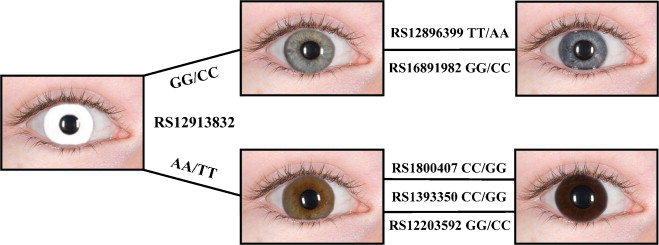Unveiling the Secrets of Eye Color Prediction: A Breakthrough Study
Forensic DNA Phenotyping (FDP) has emerged as a cutting-edge field within forensic genetics, aimed at uncovering the physical traits of unknown individuals directly from biological samples found at crime scenes. This innovative approach has the potential to revolutionize criminal investigations by providing valuable clues to help law enforcement prioritize suspects and expedite cases. Among the externally visible characteristics (EVCs) that FDP can predict, eye color stands out as one of the most well-characterized and validated traits.
In this blog post, we delve into an exciting research paper titled “A new approach to broaden the range of eye color identifiable by IrisPlex in DNA phenotyping,” authored by Ersilia Paparazzo, Anzor Gozalishvili, and their colleagues. Published in Scientific Reports in 2022, this study introduces a novel approach to enhance eye color prediction using the well-established IrisPlex system. Let’s explore the key findings and implications of this groundbreaking research.
The IrisPlex System: A Glimpse into DNA Phenotyping
Before delving into the study, it’s essential to understand the IrisPlex system’s role in predicting eye color based on genetic markers. This system relies on the analysis of six Single Nucleotide Polymorphisms (SNPs) located in different genes associated with iris pigmentation. These genes include HERC2, OCA2, SLC24A4, SLC45A2, TYR, and IRF4. The IrisPlex model employs a multinomial logistic regression approach, classifying individuals into three categories: brown, blue, or intermediate, based on the genetic data. Initially developed using data from Dutch individuals, this model has proven highly accurate for predicting brown and blue eye colors but faces challenges with intermediate shades.
The Study: A New Approach to Eye Color Prediction
The study led by Paparazzo and her team aimed to enhance the IrisPlex system’s predictive capabilities by introducing a quantitative approach to eye color prediction. They collected data from 238 individuals in a Southern Italian population, obtaining high-resolution eye images and genotype information. The innovation in this research lies in the use of clustering algorithms to objectively categorize eye colors, moving beyond the traditional qualitative visual inspection.
Key Findings: IrisPlex’s Strengths and Weaknesses
The study yielded fascinating results:
- IrisPlex excelled in predicting blue and brown eye colors with remarkable accuracy.
- However, the model faced challenges in predicting intermediate eye colors, highlighting its limitations.
- The introduction of clustering-based eye color classification significantly improved the model’s accuracy, particularly for individuals with brown eyes.
Implications: Enhancing Forensic DNA Phenotyping
These findings have far-reaching implications for forensic DNA phenotyping. The shift toward quantitative eye color classification using clustering algorithms offers a more objective and standardized approach. This method allows for a more precise definition of the phenotype under study, minimizing the subjectivity associated with visual inspection.
However, the study also underscores the need for further research to improve the IrisPlex model’s performance, especially concerning non-blue and non-brown eye colors. One promising avenue is the inclusion of epigenetic markers, which could enhance the model’s predictive accuracy and address the challenges of intermediate shades.
Conclusion
In conclusion, the study by Paparazzo and her colleagues represents a significant step forward in the field of forensic DNA phenotyping. Their innovative approach to eye color prediction offers a more objective and accurate method, holding promise for future forensic investigations. While the IrisPlex system excels in predicting certain eye colors, it still has room for improvement, particularly for those with intermediate shades. This research not only contributes to our understanding of eye color genetics but also paves the way for more precise and effective DNA intelligence tools in criminal investigations.
Written by ChatGPT based on paper and some prompt engineering!
